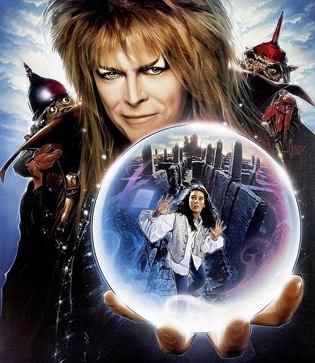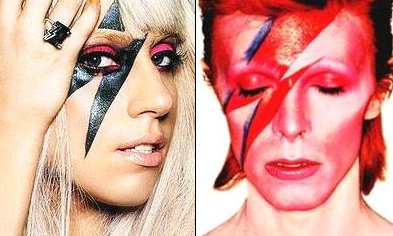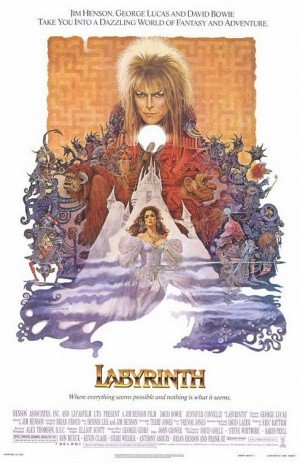“Labyrinth” Starring David Bowie: A Blueprint to Mind Control
The 1986 movie Labyrinth, starring David Bowie and Jennifer Connelly, immerses the viewers into a world of fantasy and wonder. Like many other fantastic tales, the movie conceals within its symbolism an underlying meaning and, in this case, it is rather disturbing. Labyrinth describes the programming of a mind control victim at the hands of a sadistic handler. We will look at the occult meaning of the symbolism found in Labyrinth.
By VC

Labyrinth is a quintessential 80s movie that contains everything we love from the 80s: 80s synth music, 80s CGI effects and a 80s David Bowie in the same 80s hairdo that your aunt Susan had in the 80s. What’s not to love? The movie has, in fact, become a “cult classic” and is still a children’s favorite.
But like many of these delightfully twisted fantasy movies, there is more to Labyrinth than meets the eye. By understanding the occult symbolism and references in Labyrinth, the movie becomes a big allegory for mind control, where each scene refers to a particular aspect of the process. What appears to be a young girl’s quest through a Labyrinth to find her baby brother becomes a metaphor for the internal world of a mind control victim that is being programmed by a handler. The obstacles that Sarah, the hero of the story, must go through relate to real life ordeals inflicted to mind control slaves to incite dissociation (if you have no idea what I’m talking about, read the article entitled Origins and Techniques of Monarch Mind Control). Mind games, torture, drugs and sexual abuse are all referred to in veiled symbolism during the movie, giving to “those in the know” an entirely different story than what is shown at face value. Labyrinth is therefore constructed like most esoteric works in History: it uses symbolism to conceal from the masses while revealing to the initiates.
Very little prior knowledge is required to understand the underlying meaning of Labyrinth. however. The movie was, in fact, mentioned by a few authors on mind control who described it as one of the most blatant movies on Monarch programming. Fritz Springmeier even states Labyrinth is used by actual mind control handlers as a programming script to train the slaves. This very plausible as the movie bears many similarities to Alice in Wonderland and Wizard of Oz – two movies that are known to be used in mind control programming. The only difference is that Labyrinth was probably specifically constructed to this purpose while, at the same time, exposing the masses to this kind of symbolism.
Since Labyrinth is a blueprint for mind control, it is only fitting that the star of the show is an artist who has served as a blueprint to modern pop stars: David Bowie. Throughout his long and eclectic career, Bowie has touched on many occult and ritualistic themes that are today rehashed by industry-made pop stars. And, for some reason, many of those who touch upon these occult themes also integrate mind control into their works. Maybe it is due to the fact that mind control heavily relies on black magic rituals and Kabbalistic teachings. So, before we look at the symbolism of the movie, let’s take a brief look at some of the symbolism used by David Bowie.
David Bowie: The One They All Imitated
Many articles on this site mention modern pop stars and the occult symbolism embedded in their works. It was only a matter of time before David Bowie was mentioned as he is apparently a major source of inspiration for many of them. David Bowie is indeed the prototype of the pop-star/occult icon whose works incorporated concepts originating from Secret Societies. From strange alter-egos, to the occult concept of androgyny, and of course including references to Aleister Crowley and his Thelema, Bowie did decades ago what pop stars are doing now.


Drawing the Kabbalistic Tree of Life

The difference between Bowie and today’s pop stars is that he was rather open regarding the occult influence in his act and music. In a 1995 interview, Bowie stated: “My overriding interest was in cabbala and Crowleyism. That whole dark and rather fearsome never-world of the wrong side of the brain.” In his 1971 song Quicksand, Bowie sang:
“I’m closer to the Golden Dawn
Immersed in Crowley’s uniform of imagery”
(Golden Dawn is the name of a Secret Society that had Crowley as member). These are only some examples of the occult influence on Bowie’s work and an entire book could be written on the subject.
Since the main antagonist of Labyrinth is a sorcerer who also happens to enjoy singing impromptu pop songs, David Bowie was a perfect fit for the role. Did he know that he played the role of a mind control handler?
Labyrinth

This poster of the movie Labyrinth is full of MK trigger images.
Released in 1986, Labyrinth was a collaborative effort between George Lucas, Jim Henson (his last movie) and David Bowie. Using state-of-the-art effects, the movie quickly became a classic in what we can call the “twisted fantasy” genre. The plot of the movie is simple: A teenage girl named Sarah goes through a strange, magical Labyrinth to recover her baby brother who was kidnapped by a sorcerer named Jareth and his army of goblins.
Some critics did not appreciate the random nature of the events of the movie. Robert Ebert stated that these kind of movies “aren’t as suspenseful as they should be because they don’t have to follow any logic. Anything can happen, nothing needs to happen, nothing is as it seems and the rules keep changing.” By describing the movie this way, Ebert unknowingly describes the inner-world of a mind control slave, which is exactly what the Labyrinth represents. Through trauma, the psyche of the slave is reprogrammed by the handler resulting in a situation where anything can happen, nothing needs to happen, nothing is as it seems and the rules keep changing.
Sarah’s quest for her baby brother is, in fact, a quest to recover her innocent core persona (her “real” self) that was taken by the handler. The various events that happen to Sarah are distorted reflections of real mind control trauma – hidden behind a veil of fantasy and imagination.
...MORE HERE...
02:05
|
Labels:
Film Review,
Hollyweird,
MK-ULTRA
|
- O.M.E.G.A.
- 2012
- tech
- Hollyweird
- Musicology
- Predictive Programming
- Book-Club
- F.E.A.R
- resonance
- Exopolitics
- Mega-Ritual
- ALTA
- HAARP
- burgergate
- UFO
- Ancient Aliens Theory
- Film Review
- False Flag
- Pancho B Gubbins
- Spies-R-Us
- science
- survival
- Illuminati
- MK-ULTRA
- rfsOriginals
- the sorcha faal
- Freeman
- Obama
- Pleiadians
- health
- rfsChoonz
- 911
- 99%
- Big Brother
- FFF
- History Schmystery
- PlasticMacca
- Project Bluebeam
- Toonz
- time travel
- 3D Printing
- 7/7
- Asia
- Ben Fulford
- Climate-Gate
- Japan
- Moon
- RV
- Stargate
- Synchronicity
- interview
- shoddy
- Art
- Crystal Skulls
- DNA
- Egypt
- Femen
- Geo-Engineering
- Indigo Children and Starseeds
- Libertarianism
- Permaculture
- Porton Downs
- TM
- Tesla
- iWATCH
- precog
- rfsTeez
- schmacebook
- shamanism
- skull and bones
- the27club
Popular Posts
-
...THIS guy's a frickin' PhilDickian Genius, for a start, he "occupies non linear space" which HAS to give him an advantag...
-
Bernie Suarez Activist Post With the topic of government false-flag operations being discussed throughout the country with the rec...
-
Janet Phelan Activist Post In April of 2012, Dr. Richard Holmes took a stroll in the woods in Wiltshire, England. His body was found two...
-
by Adam Parfrey "The C.I.A. and the Mafia coordinated activities because the Mafia wanted a piece of the music business...
-
To embark on the mission is to become one with it. The cosmos is beaming with electromagnetic forces. The complexity of the present time...
-
5 arguments why the Moon must be a spaceship. by Tapestry 1. The Moon's orbit is at a miraculous distance from the Earth . It is in ...
-
...is the question a legion of bloggers n twitterers n conspiracists of all stripes, have been asking (again) in the wake of THIS report cl...




0 comments:
Post a Comment